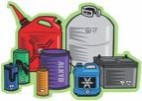
Many laboratory spaces contain some form of chemical, whether it is a buffer solution, low reactive reagents, and/or highly flammable solvents. The below information will provide guidelines for handling chemicals, how to keep an active/updated inventory (required by UK), and how to dispose of hazardous waste generated by use of chemicals.
Chematix
This refers to the university's online chemical inventory and waste management system. The system encompasses both the inventory and waste modules.
Chemical Inventory
All labs are required to have an updated chemical inventory and this inventory should be kept in the lab safety binder. Chematix is a university-wide system that also allows UK EHS to provide chemical reports to outside regulatory agencies.
If you have additional questions, please contact the A&S Space and Facilities or the EHS administrator at labsafety@uky.edu directly.
When your lab receives an expiration warning email from chematix@uky.edu, please use this guide to update the date of expiration to one year from the date the material was tested and found to still be a viable material. Do not update the expiration date if the material does not pass the test and dispose of the material immediately.
Hazardous Waste Disposal (commonly called E-trax)
Any lab that orders chemicals, should be generating hazardous wastes. Therefore, almost all labs will need to be familiar with and have access to the waste module of the Chematix system. In order to gain access to this module, you will need to complete the Hazardous Waste Training class (listed under Training Requirements). This class must be updated annually in order to maintain access to the E-trax system.
Please follow this weblink when using E-trax for the first few times. There is a very important step (#3) that many users forget to complete. This final step actually submits the hazardous waste to the Environmental Management office notifying them to pick up the container(s) within 5 business days. If your hazardous waste is still in your lab after this time frame, please check to make sure you completed this final step.
Essential Practices of Hazardous Waste Disposal:
- Renew your Hazardous Waste Training annually
- Use the hazardous waste sleeves provided by EHS (contact college safety coordinator if you need more)
- Securely close hazardous waste containers when not being actively used (must use proper lids; no parafilm, foil, etc)
- List constituents using their proper names (no formulas, abbreviations, or drawings) and place inside sleeve
- Mark hazard classifications on plastic sleeve
- Properly store hazardous waste until it is picked up (segregate from incompatibles, etc)
- All hazardous waste inside each individual container must be compatible and each container should not be stored near other containers unless they are compatible. Please see the list below for common incompatibles (this is not a comprehensive list, please review your chemicals for their incompatibilities):
- acids and bases
- organics and acids
- cyanide, sulfide or arsenic compounds and acids
- alkali or alkali earth metals, alkyllithiums, etc. and aqueous waste
- powdered or reactive metals and combustible materials
- mercury or silver and ammonium containing compounds
- All hazardous waste inside each individual container must be compatible and each container should not be stored near other containers unless they are compatible. Please see the list below for common incompatibles (this is not a comprehensive list, please review your chemicals for their incompatibilities):
- Do not overfill containers; when 90% full, complete a hazardous waste card for them and submit for pickup
- For more information use this link for detailed steps on the process of submitting hazardous waste for pickup: Hazardous Waste Management
Potentially high hazard chemicals
The list below includes chemicals that have increased hazard potential and pose a higher life safety threat when in use in the laboratory. The chemicals below are examples of what has been found in laboratories in the college. This list will be updated as other increased hazard chemicals are identified.
- Hydrofluoric Acid
- Pyrophoric chemicals
- Peroxide-forming chemicals
- Bunsen burner and natural gas usage
Chemical Use and Pregnancy
Any female lab member of child-bearing age should be especially cautious when working in the laboratory. Any chemicals that are known or suspect for causing genetic defects or having carcinogenic effects, should be worked with carefully. Lab members should also be aware of other hazards in the lab such as biological and/or radioactive material, as fetuses have much lower tolerable levels of exposure.
It is highly recommended to review all safety data sheets (SDS) that the lab member will be working with directly or exposed to in their lab environment.
